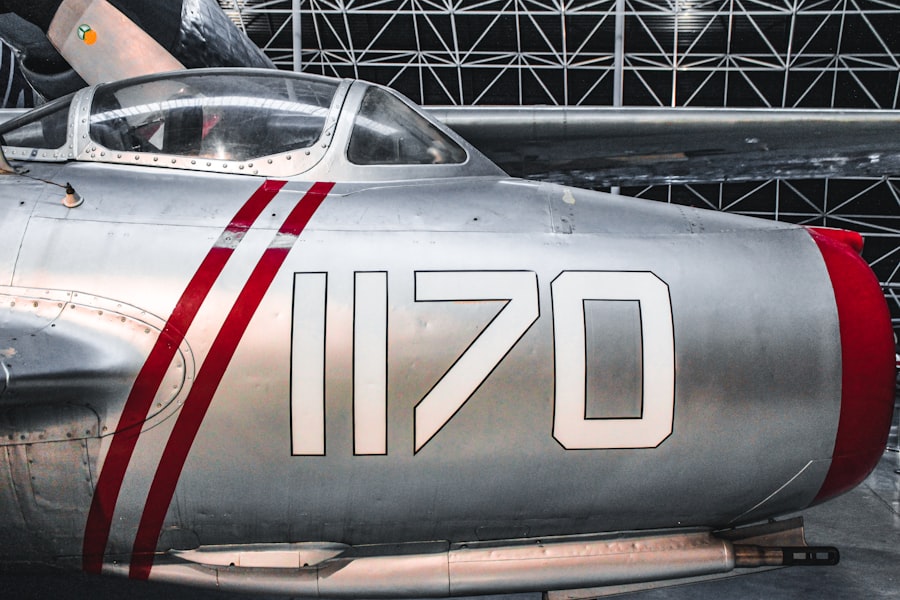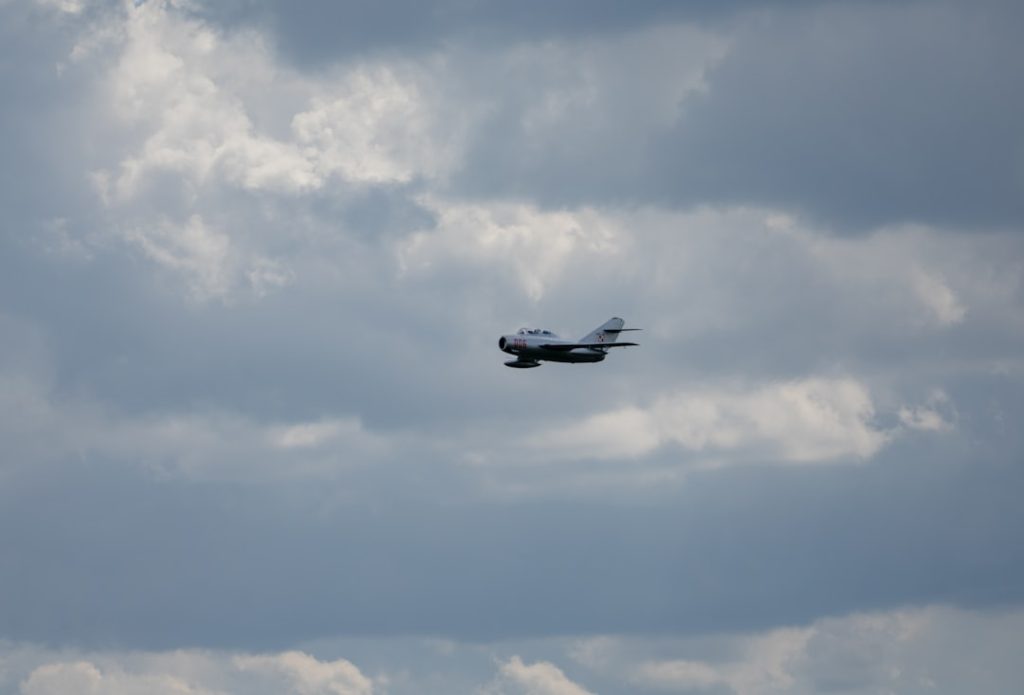The MiG-15 was born out of a pressing need for the Soviet Union to counter the growing dominance of American airpower in the post-World War II era. As the Cold War began to take shape, the United States had established a significant technological edge in aviation, particularly with the introduction of jet fighters like the F-86 Sabre. The Soviet leadership recognized that to maintain parity and project strength, they needed an aircraft that could match or exceed the capabilities of their American counterparts.
This urgency led to the development of the MiG-15, which was designed by the Mikoyan-Gurevich design bureau under the leadership of Artem Mikoyan and Mikhail Gurevich. The design process for the MiG-15 began in 1947, with the first prototype taking to the skies in 1948. Drawing inspiration from captured German technology and the latest advancements in jet propulsion, the MiG-15 featured a swept-wing design that enhanced its aerodynamic performance at high speeds.
The aircraft was powered by a Klimov VK-1 turbojet engine, which provided impressive thrust and allowed for superior maneuverability. The MiG-15’s development was not merely a response to American technology; it was also a reflection of Soviet engineering prowess and a commitment to creating a fighter that could dominate in aerial combat.
Key Takeaways
- The MiG-15 was developed by the Soviet Union in response to American airpower, showcasing the intense competition of the Cold War era.
- In the Korean War, the MiG-15 proved to be a game-changer in the skies, challenging the dominance of American aircraft and altering the course of the conflict.
- The MiG-15 was a revolutionary aircraft with advanced design and features, including swept wings and a powerful engine, setting new standards for fighter jets.
- The MiG-15 became a symbol of Soviet military might, impacting Cold War politics and contributing to the arms race between the United States and the Soviet Union.
- The MiG-15’s influence on future aircraft design and technology is evident in its lasting legacy, as it paved the way for advancements in aviation engineering.
- Famous MiG-15 pilots emerged as heroes of the Cold War, showcasing the skill and bravery required to operate this formidable aircraft in combat.
- The enduring image of the MiG-15 in popular culture is a testament to its iconic status, as it continues to captivate audiences in film and literature.
- Today, efforts to preserve the MiG-15 serve as a reminder of its historical significance and its role in shaping the geopolitical landscape of the Cold War era.
The MiG-15’s Role in the Korean War: A Game-Changer in the Skies
The MiG-15 made its combat debut during the Korean War, where it quickly established itself as a formidable adversary against United Nations forces, particularly the U.S. Air Force. The conflict, which erupted in June 1950, saw North Korean forces equipped with Soviet-supplied MiG-15s engaging in fierce dogfights with American F-86 Sabres.
The MiG-15’s performance in these encounters was nothing short of revolutionary; it was capable of reaching speeds exceeding 600 miles per hour and had a service ceiling of around 50,000 feet, allowing it to engage enemy aircraft effectively. One of the most significant aspects of the MiG-15’s role in the Korean War was its ability to challenge American air superiority. The aircraft’s combination of speed, agility, and firepower made it a game-changer on the battlefield.
In numerous engagements, MiG-15 pilots demonstrated exceptional skill and tactics, often outmaneuvering their opponents. The aircraft’s armament, which included a combination of 23mm and 37mm cannons, allowed it to inflict substantial damage on enemy bombers and fighters alike. This shift in aerial dynamics forced U.S.
forces to adapt their strategies and tactics, leading to an intense aerial arms race that characterized the conflict.
The Design and Features of the MiG-15: A Revolutionary Aircraft

The MiG-15’s design was groundbreaking for its time, incorporating several innovative features that set it apart from its contemporaries. One of its most notable characteristics was its swept-wing configuration, which significantly improved its performance at high speeds compared to straight-wing designs. This aerodynamic choice allowed the MiG-15 to maintain stability and control during high-speed maneuvers, making it particularly effective in dogfights.
In addition to its aerodynamic advantages, the MiG-15 was equipped with advanced avionics for its era. The cockpit featured a simple yet effective layout that allowed pilots to focus on flying and combat operations without being overwhelmed by complex instrumentation. The aircraft’s engine, the Klimov VK-1, was derived from the British Rolls-Royce Nene turbojet and provided reliable thrust while being relatively easy to maintain.
This combination of design elements contributed to the MiG-15’s reputation as one of the most successful jet fighters of its time.
The Impact of the MiG-15 on Cold War Politics: A Symbol of Soviet Military Might
| Metrics | Data |
|---|---|
| Introduction | The MiG-15 was a Soviet jet fighter aircraft that played a significant role in the Cold War. |
| First Flight | 1947 |
| Top Speed | 1,075 km/h (668 mph) |
| Range | 1,600 km (990 mi) |
| Armament | One 37 mm Nudelman N-37 cannon and two 23 mm Nudelman-Rikhter NR-23 cannons |
| Impact | The MiG-15’s superior performance had a significant impact on Cold War politics, leading to a shift in the balance of power. |
The MiG-15 transcended its role as a mere aircraft; it became a potent symbol of Soviet military might during the Cold War. Its deployment in Korea showcased not only Soviet technological capabilities but also their willingness to support communist allies around the globe. The presence of MiG-15s in combat zones served as a stark reminder to Western powers that the Soviet Union was prepared to engage militarily to protect its interests and ideology.
The aircraft’s success in Korea had far-reaching implications for Cold War politics. It bolstered Soviet prestige and demonstrated that they could produce advanced military technology that could compete with Western innovations. This newfound confidence led to increased military spending and further advancements in aviation technology within the Soviet Union.
The MiG-15 became a cornerstone of Soviet air strategy, influencing military doctrine and shaping international relations as both superpowers sought to assert their dominance through military strength.
The MiG-15’s Legacy: Influence on Future Aircraft Design and Technology
The legacy of the MiG-15 extends beyond its immediate impact during the Korean War; it laid the groundwork for future generations of fighter aircraft. Its design principles influenced subsequent Soviet fighters, including the MiG-17 and MiG-21, which incorporated lessons learned from the MiG-15’s performance in combat. The emphasis on swept-wing designs became a standard feature in many jet fighters developed in the following decades, as engineers recognized the advantages these configurations offered in terms of speed and maneuverability.
Moreover, the MiG-15’s success prompted Western nations to reevaluate their own aircraft designs. The U.S. Air Force responded by accelerating development programs for more advanced fighters, leading to innovations such as improved avionics, better engines, and enhanced weapon systems.
The competitive environment fostered by the MiG-15’s capabilities ultimately spurred technological advancements on both sides of the Iron Curtain, shaping military aviation for years to come.
Famous MiG-15 Pilots: Heroes of the Cold War

The MiG-15 was not only notable for its engineering but also for the skilled pilots who flew it during some of the most intense aerial battles of the Cold War. Among these aviators was Major A.
Pokryshkin, one of the most decorated pilots in Soviet history. Pokryshkin achieved numerous aerial victories while flying the MiG-15 during the Korean War and became known for his tactical acumen and innovative dogfighting techniques. His ability to outmaneuver American pilots earned him respect on both sides of the conflict.
Another prominent figure was Captain A.N. Kovalchuk, who also made significant contributions to aerial combat while piloting the MiG-15. Kovalchuk’s experiences highlighted not only individual bravery but also collective efforts among Soviet pilots to develop tactics that maximized their aircraft’s strengths against Western adversaries.
These pilots became national heroes in their homeland, symbolizing Soviet resilience and determination during a time when air superiority was crucial for military success.
The MiG-15 in Popular Culture: Its Enduring Image in Film and Literature
The MiG-15 has left an indelible mark on popular culture, appearing in various films, literature, and media that depict Cold War-era conflicts. Its sleek design and formidable reputation have made it an iconic representation of Soviet aviation prowess. Films such as “The Bridges at Toko-Ri” (1954) showcased intense aerial dogfights between American F-86 Sabres and North Korean MiG-15s, capturing audiences’ imaginations while highlighting the technological rivalry between East and West.
In literature, authors have often referenced the MiG-15 as a symbol of Cold War tensions and military strategy. Novels set during this period frequently feature characters who are pilots or military strategists grappling with the implications of air power on global politics. The aircraft’s presence serves as a reminder of how aviation technology shaped not only military outcomes but also cultural narratives surrounding heroism, sacrifice, and national identity.
The MiG-15 Today: Preserving a Piece of Cold War History
Today, the MiG-15 is preserved as an important artifact of Cold War history, with many examples displayed in museums around the world. Aviation enthusiasts and historians recognize its significance not only as a military aircraft but also as a symbol of an era defined by ideological conflict and technological competition. Various airshows feature restored MiG-15s that perform flight demonstrations, allowing new generations to appreciate its design and capabilities firsthand.
Moreover, efforts are underway to ensure that this iconic aircraft remains part of public consciousness through educational programs and exhibitions that explore its historical context. By preserving the MiG-15, we maintain a connection to a pivotal moment in aviation history and remind ourselves of how technological advancements can shape geopolitical landscapes. As we reflect on its legacy, we gain insight into both past conflicts and future challenges in military aviation and international relations.


